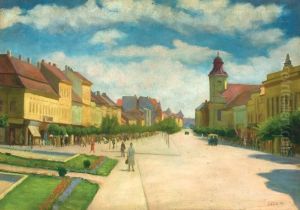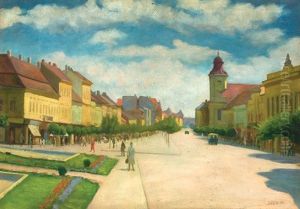Nandor Deak Paintings
Nandor Deak was a Hungarian artist, born in 1894 in the Austro-Hungarian Empire, in a region that is now part of Romania. His early life was marked by the diverse cultural influences of the Austro-Hungarian Empire, which would later be reflected in his eclectic artistic style. Deak's work spans a variety of mediums, including painting, sculpture, and printmaking, showcasing his versatility as an artist. Despite the challenges posed by the two World Wars and the shifting political landscape of Europe in the 20th century, Deak managed to maintain a consistent output of work, much of which delved into themes of identity, displacement, and the human condition.
Deak's education in the arts began in Budapest, where he attended the Hungarian University of Fine Arts. His studies were interrupted by World War I, during which he served in the Austro-Hungarian Army. The experiences and horrors of war deeply affected Deak, influencing his subsequent artworks which often depicted the brutalities of conflict and the resilience of the human spirit. After the war, he continued his studies, traveling across Europe to learn from various art movements of the time, including Expressionism and Surrealism, which he later incorporated into his own unique style.
In the interwar period, Deak became an active participant in the Hungarian art scene, contributing to the development of modern art in Hungary. His work from this period reflects a fascination with the human psyche, often exploring themes of existentialism and introspection. Despite the rise of political extremism in Europe, Deak remained committed to his art, using it as a means to critique the social and political turmoil of his time.
The outbreak of World War II and the subsequent Soviet occupation of Hungary had a profound impact on Deak's life and work. During the communist regime, he faced censorship and was forced to adapt his artistic expressions to fit the socialist realist style that was mandated by the government. However, Deak's commitment to exploring the depths of human emotion and experience remained unshaken, and he continued to produce work that was rich in symbolism and depth.
Deak's legacy is that of a resilient artist who navigated the complexities of the 20th century with unwavering dedication to his craft. His body of work, which encompasses a broad range of styles and themes, offers a poignant commentary on the human condition, war, and the quest for identity amidst the backdrop of a tumultuous century. Nandor Deak passed away in 1973, leaving behind a rich and diverse portfolio that continues to be celebrated for its artistic and historical significance.

